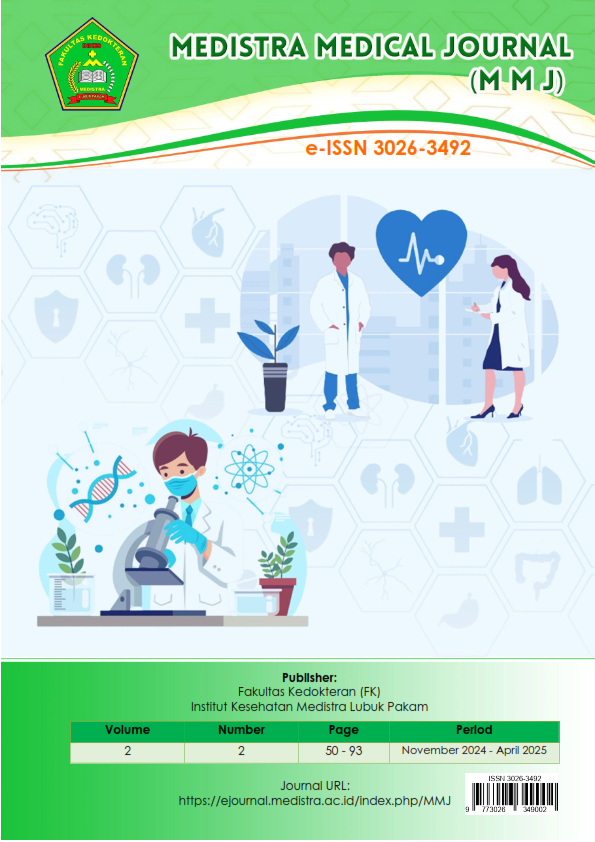Improving General Practitioners’ Competence in Catastrophic Emergency Management through Simulation-Based Training at Grandmed General Hospital Lubuk Pakam in 2023
DOI:
https://doi.org/10.35451/s5n4t088Keywords:
simulation training , general practitioners , competence , catastrophic emergency , disaster management .Abstract
Catastrophic emergencies present major challenges for health care systems because they involve large numbers of victims, diverse clinical conditions, and limited resources. General practitioners, as the frontline providers in hospitals, are required to have optimal competencies in initial management, triage, resuscitation, and team coordination. This study aimed to evaluate the effectiveness of simulation-based training in improving the competence of general practitioners at Grandmed General Hospital Lubuk Pakam in 2023. The research employed a pre-test and post-test design with a quantitative approach. The study sample consisted of 30 general practitioners selected through total sampling. Data collection instruments included a knowledge questionnaire, skills checklist, and performance observation during the simulation. The findings revealed a significant improvement in the average competence scores of general practitioners after the training. The mean pre-test score was 65.3 (categorized as fair), which increased to 85.7 (categorized as good) in the post-test. Improvements were observed in several aspects: knowledge (29.6%), clinical skills (32.9%), team coordination (31.1%), decision-making (32.7%), and self-confidence (29.7%). Statistical analysis showed a significant difference (p < 0.05) between pre-test and post-test results. These findings confirm that simulation-based training is an effective method for enhancing the preparedness of general practitioners in handling disaster scenarios. In conclusion, simulation-based training has proven effective in improving the knowledge, clinical skills, and readiness of general practitioners at Grandmed General Hospital Lubuk Pakam. It is recommended that such training be conducted regularly, expanded to include other health professionals, and established as a key hospital strategy for strengthening preparedness in catastrophic emergency management.
References
[1] Al-Elq, A.H. (2010). Simulation-based medical teaching and learning. Journal of Family & Community Medicine, 17(1), 35–40
[2] Arifin, Z. (2021). Efektivitas Pelatihan Simulasi Bencana terhadap Kesiapsiagaan Tenaga Kesehatan di Puskesmas Wilayah Rawan Tsunami. Jurnal Kesehatan Masyarakat Indonesia, 16(2), 101–110.
[3] Badan Nasional Penanggulangan Bencana (BNPB). (2022). Laporan Tahunan Data dan Informasi Bencana di Indonesia. Jakarta: BNPB.
[4] Haji, S., et al. (2020). The Impact of Simulation-Based Training on Emergency Preparedness of Health Workers. Journal of Emergency Medicine, 58(4), 465–472.
[5] Lestari, D., & Putra, A. (2020). Peningkatan Kompetensi Klinis melalui Simulasi Medis Interaktif. Jurnal Pendidikan Kedokteran Indonesia, 9(3), 145–153.
[6] Okuda, Y., & Bryson, E.O. (2020). The Utility of Simulation in Medical Education: What Is the Evidence? Academic Medicine, 95(5), 707–713.
[7] Susanti, N. (2020). Kesiapsiagaan Rumah Sakit dalam Penanganan Bencana Massal. Jurnal Administrasi Rumah Sakit Indonesia, 6(1), 33–42.
[8] Tan, K., & Lo, S. (2018). Disaster Preparedness Training for Healthcare Providers: A Systematic Review. International Journal of Disaster Risk Reduction, 31, 111–117.
[9] Widodo, S., & Santosa, A. (2020). Simulasi sebagai Metode Efektif dalam Pembelajaran Kegawatdaruratan. Jurnal Kesehatan, 12(2), 77–85.
[10] Zulkifli, H. (2022). Manajemen Kegawatdaruratan Katastropik di Rumah Sakit: Tantangan dan Strategi. Jurnal Manajemen Kesehatan Indonesia, 10(2), 89–98.
Downloads
Published
Issue
Section
License
Copyright (c) 2025 Peni rio Ginting

This work is licensed under a Creative Commons Attribution 4.0 International License.
Copyright in each article is the property of the Author.
















